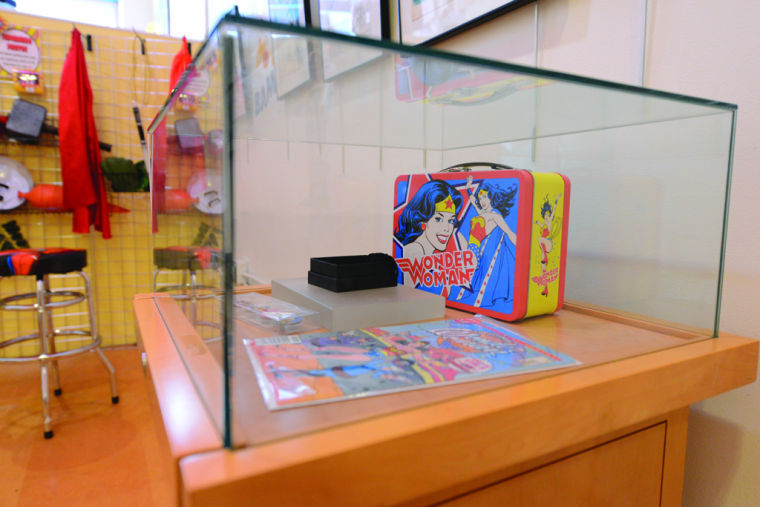Toonseum Celebrates Wonder Woman
March 5, 2014
The design and decoration of the Toonseum, located on Liberty Avenue downtown, is appropriately eccentric for one of just three cartoon museums in the United States. “Bam!” and “Pow!” are printed above the entrance in red and blue bubbles. From there, the museum greets customers with a gift shop, that more closely resembles a comic shop featuring a large collection of comics, graphic novels and action figures. Beyond that is the first of two exhibits that regularly change throughout the year.
This time around, one of those exhibits is all about what might be America’s greatest female comic icon: Wonder Woman.
Although National Women’s Month has just begun, the newest ToonSeum exhibit, “Wonder Woman: On Page and Off,” has been on display for more than a month. It runs until March 30 and features about 50 pieces of cartoon art and comic strips, representing female characters front and center. There’s more than just Wonder Woman, though. In fact, there are female characters in roles of all kinds, from heroines to housewives. The exhibit represents women from a woman’s point of view.
For the new “Wonder Woman” exhibit, Joe Wos, the executive director of the ToonSeum, said he’s excited to try something new.
“We really wanted to do something different with this exhibit,” Wos, executive director and founder of the ToonSeum, said.
The artwork is spread across the first room of the exhibit, organized by time from the Great Depression to the Underground era and second-wave feminism that began in the 1960s. It shows a distinct evolution in the world of comics and the barriers that women broke. Another distinct aspect of the exhibit is that almost all of the art is drawn entirely by female artists.
“More than 90 percent of the comics are drawn by women portraying women,” Wos said.
Whether the women are sex symbols or housewives, this layer of the exhibit denotes the struggles women faced through the years, and it shows the different ways women have portrayed themselves over time.
There are only two exceptions to this female-drawn, female-only dynamic. The “We Can Do It!” poster created by Pittsburgh artist J. Howard Miller was included because of its iconic portrayal of Rosie the Riveter. The second exception is a piece depicting Andy Warhol that they decided to include because of its relation to Pittsburgh.
Alexa Dickinson Pontzer, executive assistant at the ToonSeum, said that she believes the exhibit can be a source of inspiration for modern women.
“I think it’s very important that women who want to do something can do it,” Pontzer said.
Pittsburgh has its own history of successful female cartoonists. Pittsburgh-area native Jackie Ormes, the first African-American female cartoonist, penned cartoons for African-American newspapers such as The Chicago Defender and Pittsburgh Courier. Pittsburgh is also the city in which Miller created the iconic “We Can Do It!” poster.
In the exhibit, there’s also a presence — however small — of local female comic artists within the area. Mandi Bridgeman, the marketing and programming director of the ToonSeum, was involved in finding these Pittsburgh artists and bringing their work into the exhibit.
“It was a challenge because there’s a very select number of local woman artists in the Pittsburgh area,” Bridgeman said.
Some of these artists include Diana Zourelias, Lizzee Solomon and Nora Thompson, all of whom contributed a piece to the show.
But while other female characters receive some attention, Wonder Woman remains at the center of any discussion about portrayals of women in comics.
Wonder Woman was created in the early 1940s by psychologist William Moulton Marston. Marston developed the character at the suggestion of his wife, Elizabeth Marston, at a time when DC Comics was dominated by male characters such as Batman, Green Lantern and Superman during World War II. She was created as an icon to whom women could relate, though creative control remained in the hands of men.
Because of Wonder Woman’s history and conception, it was hard to find artwork of her that was drawn entirely by female artists. That’s where iconic comic artist and Wonder Woman cartoonist Trina Robbins came in.
A good portion of the exhibit derives from Robbins’ personal collection. Robbins, an expert in women’s comics and a self-titled “herstorian,” started as an underground artist in San Francisco in the ’70s and ’80s before she began work on mainstream comics. Her career in the comic world spans 30 years, with five published books and an involvement drawing Wonder Woman since the early ’80s.
“We wanted to feature Wonder Woman. For that, we had to rely heavily on Trina Robbins,” Wos said.
Other comics featured in the exhibit include “The Pajama Diaries” by Terri Libenson and “For Better or for Worse” by Lynn Johnston. Twenty-five pieces in the exhibit also come from Wos’ own collection.
“I started collecting them while attending Carlow University. It’s my connection to this history,” Wos said.
For Pontzer, each of these pieces is a testament to the way these women persevered in a medium through which they were distinctly underrepresented.
“The fact that women had to jump through hoops and break barriers to create this art is incredible,” Pontzer said. “I can’t think of anywhere else where I can go to see this kind of amazing artwork.”








